HDFC Long Term Advantage Fund Invest Online

Some investors will remember that in the good old days, when you could double your money in just over 5 years by investing in National Savings Certificates. Unfortunately it is not possible these days, certainly not risk free. However, if the investors are willing to take some risks, it is possible to get even better returns. Take the case of HDFC Long Term Advantage Fund. Investment in the fund 5 years back would have nearly tripled in value. In addition, by virtue of being a tax-saving fund, investment in the fund would qualify for tax deduction under section 80C of the Income Tax Act. Tax-saving funds, also known as Equity Linked Saving Schemes (ELSS), are open ended equity funds with a lock in period of three years from the date of the investment. If you invest in an ELSS through a systematic investment plan (SIP), each investment will be locked in for 3 years from their respective investment dates. From tax purposes, both long term capital gains and dividends from ELSS are tax free. Over various time periods, ELSS funds have generated even better returns than diversified equity funds. The lock-in period of three years in ELSS is advantageous from a fund management perspective, since the fund managers are free from redemption pressures during the lock-in period and therefore are able to hold the stocks in their portfolio for a longer period of time, to generate superior returns.
HDFC Long Term Advantage Fund, which has completed over 13 years, is clearly one of the top performers in the ELSS category across several time periods. See the chart below, for the comparison of annualized returns over one, three, five and ten year periods, from HDFC Long Term Advantage Fund (Growth Option) and the ELSS Category (NAVs as on Apr 22).
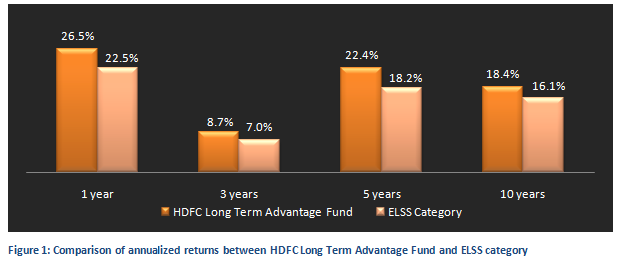
HDFC Long Term Advantage Fund – Fund Overview
This fund is suitable for investors looking for tax planning investment options under 80C with the expectation of long term capital appreciation. Equity funds as an asset class generate superior returns over the long term and serves as an effective hedge against inflation. However, equity funds are subject to market risk and volatility, compared to other tax saving instruments like PPF, NSC etc. As such, the fund is suitable for investors planning for long term financial objectives like retirement planning, children's education, marriage etc. The HDFC Long Term Advantage Fund was launched in January 2001. The scheme is open both for growth and dividend plans. The fund has an AUM base of over Rs 900 crores, with an expense ratio of 2.25%. HDFC AMC is the largest asset management company in India, and is widely recognized as amongst the top performers across many mutual fund categories. The fund manager of this scheme is Chirag Setalvad and Rakesh Vyas. The current NAV (as on April 22 2014) is 181.91 for the growth plan and 33.11 for the dividend plan.
Portfolio Construction
The fund managers have a large cap bias and with a high growth focus. From a sector perspective, the portfolio has a higher weighting for cyclical sectors like BFSI, Automobile and Energy, but it also has substantial allocations to defensive sectors like IT and FMCG. This portfolio construction enables the fund manager to get good returns across different market conditions. In terms of company concentration, the portfolio is reasonably well diversified with its top 5 holdings, ICICI Bank, TCS, Infosys, Larsen and Toubro, accounting for 33% of the total portfolio value.
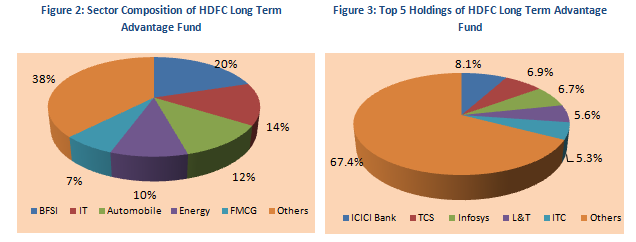
Risk & Return
From a risk perspective, the volatility of the fund is in line with the ELSS category. The annualized standard deviations of monthly returns of HDFC Long Term Advantage Fund for three to ten year periods are in the range of 17% and 24% respectively. However on a risk adjusted return basis, as measured by Sharpe Ratio, the fund has outperformed the ELSS category. See charts below for comparison of volatilities and Sharpe ratios between HDFC Long Term Advantage Fund and ELSS funds category
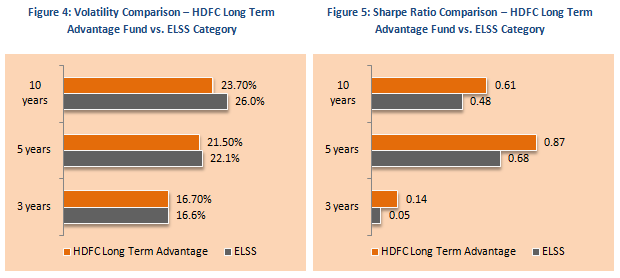
Comparison with Peer Set
A comparison of annualized returns of HDFC Long Term Advantage Fund versus its peer set over various time periods shows why this fund is considered a good ELSS investment. The fund has beaten most of its peers, except ICICI Prudential Tax Plan in the three and five year time periods. See chart below for comparison of annualized returns over three, five year and 10 year periods. NAVs as on Apr 22.
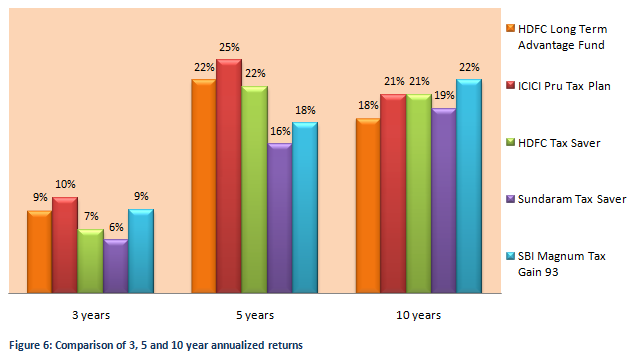
Dividend Payout Track Record
HDFC Long Term Advantage Fund, dividend option, has an excellent dividend payout track record. The fund has paid dividends every year since inception, even during the market downturns in 2008 and 2011. This demonstrates the good track record of the fund even under difficult market conditions.
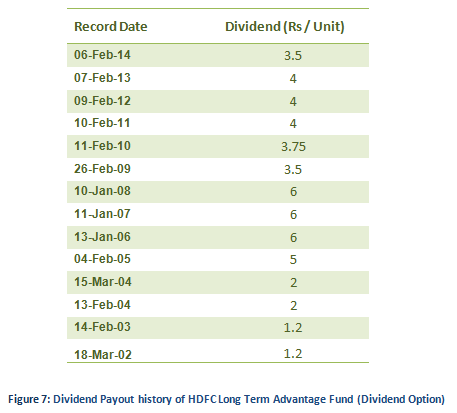
Lump Sum and SIP Returns
A lump sum investment of Rs 1 lakh in the HDFC Long Term Advantage Fund five years back would have nearly tripled and grown to around Rs 2.75 lakhs. If you invested Rs 1 lakh lump sum in the NFO of the fund in 2001, your investment would have grown to Rs 18.2 lakhs. The chart below shows the growth of standard Rs 10,000 investment over various time periods.
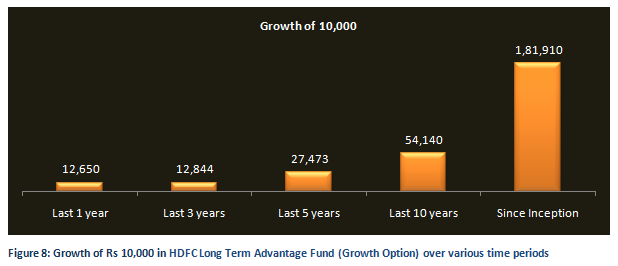
The chart below shows returns as on Apr 22 2014 (NAV of 181.91) of Rs 5000 monthly SIP in the HDFC Long Term Advantage Fund Growth Option, for respective years since inception (in January 2001). The SIP date has been assumed to first working day of the month. The amounts are shown in Rs lakhs.
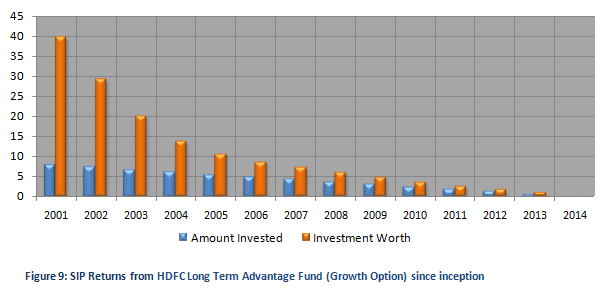
The chart above shows that, a monthly SIP of Rs 5000 from the first working day of the month since inception would have grown to nearly Rs 40 lakhs, while the investor would have invested in total less than Rs 8 lakhs. This would imply an internal rate of return of nearly 20%, which is much higher than returns of some other tax saving investments (e.g. PPF) in the same period. If the investor started his SIP ten years back, his or her corpus would have grown to nearly Rs 14 lakhs, with an investment of only Rs 6 lakhs.
Conclusion
The HDFC Long Term Advantage Fund has delivered nearly over 13 years of strong and consistent performance. The fund has established itself as a good tax saving scheme with strong track record of investment returns and dividends. HDFC AMC is the largest AMCs in the country and funds from the HDFC stable are among top performers across several mutual fund categories. Investors planning for tax saving investments can consider buying the scheme through the systematic investment plan (SIP) or lump sum route for long term financial objectives. The fund has an excellent dividend payout track record, and as such may appeal to investors who prefer tax free dividends. Investors should also ensure that the objectives of the fund are aligned with their individual risk profiles and time horizons. Investors should consult with their financial advisors if the HDFC Long Term Advantage Fund is suitable for their investment portfolio.
Top 10 Tax Saving Mutual Funds to invest in India for 2016
Best 10 ELSS Mutual Funds in india for 2016
1. BNP Paribas Long Term Equity Fund
2. Axis Tax Saver Fund
3. Franklin India TaxShield
4. ICICI Prudential Long Term Equity Fund
5. IDFC Tax Advantage (ELSS) Fund
6. Birla Sun Life Tax Relief 96
7. DSP BlackRock Tax Saver Fund
8. Reliance Tax Saver (ELSS) Fund
9. Religare Tax Plan
10. Birla Sun Life Tax Plan
Invest in Best Performing 2016 Tax Saver Mutual Funds Online
For further information contact Prajna Capital on 94 8300 8300 by leaving a missed call
---------------------------------------------
Leave your comment with mail ID and we will answer them
OR
You can write to us at
PrajnaCapital [at] Gmail [dot] Com
OR
Leave a missed Call on 94 8300 8300
-----------------------------------------------